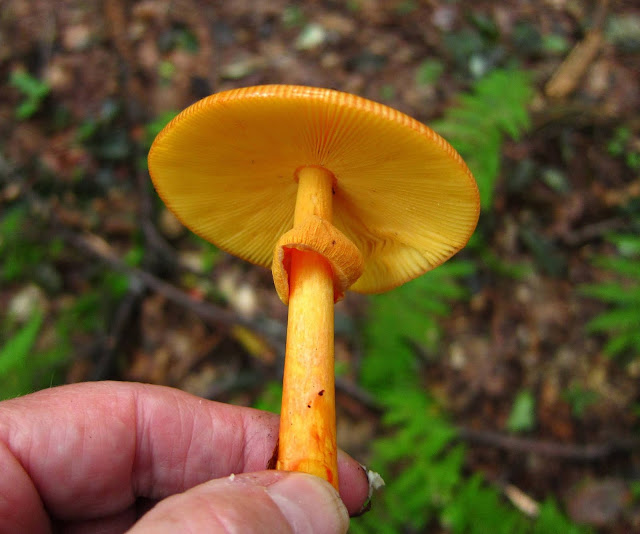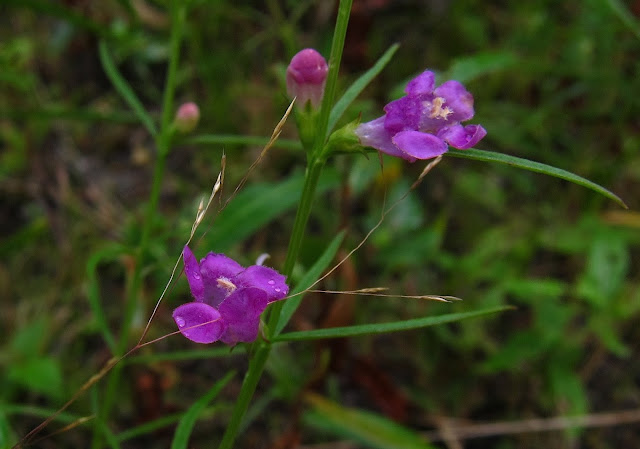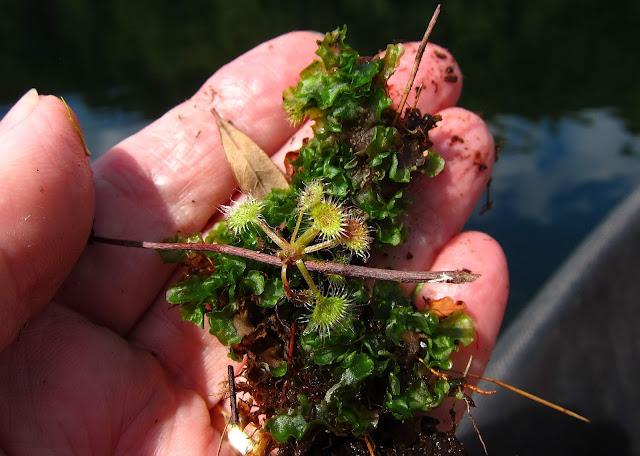My friend Sue met me at the Hawk Rd. entrance near Lake Luzerne, and together we survived the jolting half-mile drive to the parking area. I was eager to show her the three plants I find over here, where the soil has a somewhat different composition than it does in the Saratoga County parts of the park. And who could know what else we might find as we walked the pleasant old road that still provides access to the Spier Falls Dam? We took this old road instead of the wooded trails, mostly because it offered easier traveling on this brutally hot and humid day, and also because we might find more blooming along this open roadway than we would in the dark shade of the forest.
The first flower we found, almost as soon as we stepped from the car, were dozens and dozens of Purple Milkwort flowers (Polygala sanguinea), a plant that prefers the dry, thin, rocky soil that surrounds the parking area here. Some years I find only a few, but this year they were abundant. State distribution maps indicate that this flower is not rare and occurs widely across the state. But I never find it anywhere else but here. And I do get around!
Here's a closer photo I took from my files, the better to show the beautiful structure of the Purple Milkwort blooms, like miniature bouquets of multicolored flowers wrapped in purple tissue paper.
Here is another flower, American Pennyroyal (Hedeoma pulegioides) that state records indicate is a common and widespread plant. But I have never found it anywhere but here on the Warren County side of the Hudson River. And I have looked for it elsewhere for years. I grant it would be easy to overlook, tiny as it is, with flowers that fall from the three-toothed bracts at a touch. But all you have to do is pass near a patch of it, and the strong minty fragrance reaches out to tell you "Here I am!" Some years I search and search this site, only to find a couple of struggling plants, but this year the patch was vigorous and plentiful.
Slender Three-seeded Mercury (Acalypha gracilens) is probably not as uncommon as the NY state floral distribution map would indicate. I think it is more likely just overlooked by botanists, little nondescript weed that it appears to be. Its flowers are just little ruddy nubbins borne in the leaf axils, but they are surrounded by winged bracts that are far more interesting to look at than the almost invisible flowers. After all, these winged bracts, resembling the wings on the heels of the Roman god Mercury, are what inspired this plant's common name. Nestling within those bracts are tight little clusters of three seeds, contributing inspiration for the other part of the common name. I have found this little native American plant in only two places in all my years of wildflower hunting, but I bet it's hiding out in lots of other places, too. I'm happy I consistently find it over here on the Warren County side of the park, and this year the plants looked healthier than ever (if always a little bug-eaten).
This photo reveals the tiny glandular hairs on the winged bracts, a feature that distinguishes this Acalypha gracilens from the much more common vacant-lot weed, Acalypha rhomboidea.
The tiny cluster of three seeds contained within the winged bracts are doubtless what inspired this plant's name of Three-seeded Mercury.
We managed to walk at least a couple of miles this day, there and back again, finding lots of beautiful mosses and colorful fungi as well. But not many other flowers, aside from Tall Goldenrods and the ubiquitous Bonesets that crowded the road. We might have gone further, but I began to feel absolutely enervated from the heat and humidity and begged to go home. I was too tired to even take more photos, so I'm posting this photo from an earlier outing to Moreau Lake the Friday before. This was the first Monarch Butterfly I had seen all summer, one of at least three I saw feeding on the Bonesets that grow on the shore of the lake. Let's hope that populations are recovering, now that people are becoming more aware of the importance of nurturing milkweeds for their larvae.
And this was a lovely Swamp Thistle (Cirsium muticum) I found growing along Bog Meadow Trail last week. We have five thistles that are native to New York, and this is one of the prettiest. I think its buds are beautiful, too, finely interwoven with fibers as fine as spider silk and with a texture that is reminiscent of elegantly jeweled Easter eggs.








































































